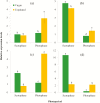Copulation Exerts Significant Effects on mRNA Expression of Cryptochrome Genes in a Moth
- PMID: 30817821
- PMCID: PMC6394973
- DOI: 10.1093/jisesa/iez016
Copulation Exerts Significant Effects on mRNA Expression of Cryptochrome Genes in a Moth
Abstract
It is recognized that the behavioral rhythms of organisms are controlled by the circadian clock, while the reverse direction, i.e., whether changes in physiology and behavior react to the internal rhythms, is unclear. Cryptochromes (CRYs) are photolyase-like flavoproteins with blue-light receptor function and other functions on circadian clock and migration in animals. Here, we cloned the full-length cDNA of CRY1 and CRY2 in Spodoptera litura (Fabricius, 1775) (Lepidoptera: Noctuidae). Sl-CRYs show high similarity to orthologs from other insects, and their conserved regions contain a DNA photolyase domain and a FAD-binding seven domain. The expression levels of both genes were relatively low during the larval stage, which increased during the pupal stage and then peaked at the adult stage. The expression of Sl-CRY1 and Sl-CRY2 showed differences between males and females and between scotophase and photophase. Further, our study demonstrated that copulation has a significant effect on the expression of Sl-CRYs. More interestingly, the changes in the expression of Sl-CRY1 and Sl-CRY2 due to copulation showed the same trend in both sexes, in which the expression levels of both genes in copulated males and females decreased in the subsequent scotophase after copulation and then increased significantly in the following photophase. Considering the nature of the dramatic changes in reproductive behavior and physiology after copulation in S. litura, we propose that the changes in the expression of Sl-CRYs after copulation could have some function in the reproductive process.
Keywords: CRY1; CRY2; Spodoptera litura; copulation; cryptochrome.
© The Author(s) 2019. Published by Oxford University Press on behalf of Entomological Society of America.
Figures




Similar articles
-
Molecular cloning, characterization, and mRNA expression of two Cryptochrome genes in Helicoverpa armigera (Lepidoptera: Noctuidae).J Econ Entomol. 2013 Feb;106(1):450-62. doi: 10.1603/ec12290. J Econ Entomol. 2013. PMID: 23448062
-
Knockout of cryptochrome 1 disrupts circadian rhythm and photoperiodic diapause induction in the silkworm, Bombyx mori.Insect Biochem Mol Biol. 2024 Sep;172:104153. doi: 10.1016/j.ibmb.2024.104153. Epub 2024 Jul 2. Insect Biochem Mol Biol. 2024. PMID: 38964485
-
Molecular characterization, tissue and developmental expression profiles of cryptochrome genes in wing dimorphic brown planthoppers, Nilaparvata lugens.Insect Sci. 2016 Dec;23(6):805-818. doi: 10.1111/1744-7917.12256. Epub 2015 Oct 26. Insect Sci. 2016. PMID: 26227859
-
Structure and expression of a cysteine proteinase gene from Spodoptera litura and its response to biocontrol fungus Nomuraea rileyi.Insect Mol Biol. 2014 Apr;23(2):255-68. doi: 10.1111/imb.12078. Epub 2014 Jan 28. Insect Mol Biol. 2014. PMID: 24467606
-
Light-induced cryptochrome 2 liquid-liquid phase separation and mRNA methylation.New Phytol. 2024 Dec;244(6):2163-2169. doi: 10.1111/nph.20201. Epub 2024 Oct 21. New Phytol. 2024. PMID: 39434460 Review.
Cited by
-
Mating-Induced Differential Expression in Genes Related to Reproduction and Immunity in Spodoptera litura (Lepidoptera: Noctuidae) Female Moths.J Insect Sci. 2020 Jan 1;20(1):10. doi: 10.1093/jisesa/ieaa003. J Insect Sci. 2020. PMID: 32092133 Free PMC article.
-
Draft genome of a biparental beetle species, Lethrus apterus.BMC Genomics. 2021 Apr 26;22(1):301. doi: 10.1186/s12864-021-07627-w. BMC Genomics. 2021. PMID: 33902445 Free PMC article.
-
Males of Aedes aegypti show different clock gene expression profiles in the presence of conspecific females.Parasit Vectors. 2022 Oct 18;15(1):374. doi: 10.1186/s13071-022-05529-8. Parasit Vectors. 2022. PMID: 36258200 Free PMC article.
-
CRY1 is involved in the take-off behaviour of migratory Cnaphalocrocis medinalis individuals.BMC Biol. 2024 Aug 13;22(1):169. doi: 10.1186/s12915-024-01964-4. BMC Biol. 2024. PMID: 39135045 Free PMC article.
-
Light and dark cycles modify the expression of clock genes in the ovaries of Aedes aegypti in a noncircadian manner.PLoS One. 2023 Oct 19;18(10):e0287237. doi: 10.1371/journal.pone.0287237. eCollection 2023. PLoS One. 2023. PMID: 37856474 Free PMC article.
References
-
- Ahmad M., Saleem M. A., and Sayyed A. H.. . 2009. Efficacy of insecticide mixtures against pyrethroid- and organophosphate-resistant populations of Spodoptera litura (Lepidoptera: Noctuidae). Pest Manag. Sci. 65: 266–274. - PubMed
-
- Armes N. J., Wightman J. A., Jadhav D. R., and Rao G. V. R.. . 1997. Status of insecticide resistance in Spodoptera litura in Andhra Pradesh, India. Pestic. Sci. 50: 240–248.
-
- Busza A., Emery-Le M., Rosbash M., and Emery P.. . 2004. Roles of the two Drosophila cryptochrome structural domains in circadian photoreception. Science. 304: 1503–1506. - PubMed
-
- Cashmore A. R. 2003. Cryptochromes: enabling plants and animals to determine circadian time. Cell. 114: 537–543. - PubMed
MeSH terms
Substances
LinkOut - more resources
Full Text Sources

